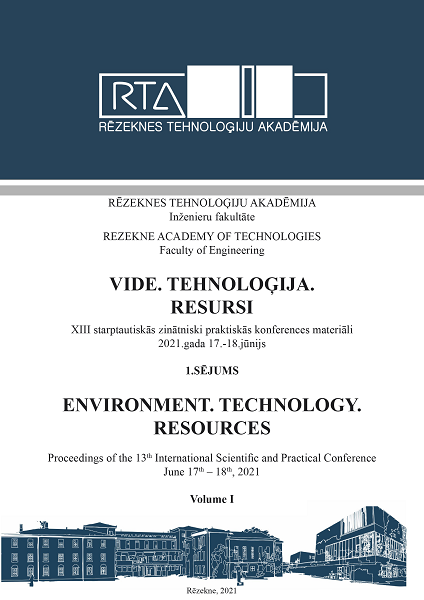USING OF AIRBORNE LIDAR ALTIMETRY AND SEMI-AUTOMATED GIS TOOLS FOR IDENTIFICATION AND MAPPING OF FLUVIAL TERRACES IN THE AUGŠDAUGAVA SPILLWAY VALLEY
DOI:
https://doi.org/10.17770/etr2021vol1.6645Keywords:
Augšdaugava spillway valley, DEM, fluvial terraces, GIS, LiDARAbstract
River terraces are one of the typical and widespread Quaternary fluvial landforms in Latvia. Until recently, distinguishing and mapping of these features have required extensive field surveys. However, the availability of high resolution digital elevation models (DEM) derived from airborne laser altimetry and application of modern geographic information systems (GIS) provides sufficient background to resolve these tasks. In this study, we apply an integrated methodology based on using of remote sensing, i.e. laser scanning or Light Detection and Ranging (LiDAR) data and combining of semi-automated TerEx tools for the detection of fluvial terraces in DEM. The empirical tests performed using the tools in the study area reveal that the application of TerEx gives the reliable results. However, presence of minor landforms which increase the topographical roughness of the surface directly influence the quality of extracted data, thus leading to the necessity of additional manual editing. The obtained data indicate that the terrace sequence in the Augšdaugava spillway valley consists of eight different terrace levels – T1 to T8. Only terraces T1 and T2 are easily recognizable in the study area, whereas the upper terraces do not have explicit edges.
Downloads
References
G. Eberhards, Upju ieleju veidošanās un mūsdienu gultnes procesi Dienvidaustrumu Baltijā (Development of river valleys and channel processes in Southeatern Baltic), in Latvian. Rīga: Latvijas Universitāte, 2013, pp. 211.
R. Charlton, Fundamentals of fluvial geomorphology, London: Routledge, 2009, pp. 163.
M. A. Summerfield, Global geomorphology, Harlow: Longman, 1999, pp. 224-225.
F.J. Pazzaglia, “Fluvial terraces (chapt. 9.22.),” In Treatise on Geomorphology, F.S. John, Ed. San Diego: Academic Press, 2013, pp. 379–412.
G.S. Hancock, R.S. Anderson, “Numerical modeling of fluvial strath terrace formation in response to oscillating climate,” GSA Bulletin, vol. 114 (9), pp. 1131–1142, Sept. 2002. https://doi.org/10.1130/0016-7606(2002)114<1131:NMOFST>2.0.CO;2
V. Zelčs, A. Markots, M. Nartišs, T. Saks, “Pleistocene Glaciations in Latvia,” In Developments in Quaternary Science, vol. 15, J. Ehlers, P.L. Gibbard, P.D. Hughes (Eds.). Amsterdam: Elsevier, 2011, pp. 221–229.
J. C. Stout, P. Belmont, “TerEx Toolbox for semi-automated selection of fluvial terrace and floodplain features from LiDAR,” Earth Surface Processes and Landforms, vol. 39 (50), pp. 569–580, Apr. 2014. https://doi.org/10.1002/esp.3464
A. Demoulin, B. Bovy, G. Rixhon, Y. Cornet, “An automated method to extract fluvial terraces from digital elevation models: The Vesdre valley, a case study in eastern Belgium,” Geomorphology, vol. 91 (1–2), pp. 51–64, Oct. 2007. https://doi.org/10.1016/j.geomorph.2007.01.020
M. del Val, E. Iriarte, M. Arriolabengoa, A. Aranburu, “An automated method to extract fluvial terraces from LIDAR based high resolution Digital Elevation Models: The Oiartzun valley, a case study in the Cantabrian Margin,” Quaternary International, vol. 364, pp. 35-43, Apr. 2015. https://doi.org/10.1016/j.quaint.2014.10.030
Latvian Geospatial Information Agency, “Digital Height Model Basic data,” LGIA, Open data, 2021. [Online]. Available: https://www.lgia.gov.lv/lv/Digit%C4%81lais%20virsmas%20modelis [Accesed: Jan. 17, 2021]
G. Sithole, G. Vosselman, “Experimental comparison of filter algorithms for bare-Earth extraction from airborne laser scanning point clouds,” ISPRS J. Photogramm. Remote Sens., vol. 59 (1–2), pp. 85–101, Aug. 2004. https://doi.org/10.1016/j.isprsjprs.2004.05.004
N. Polat, M. Uysal, A. S. Toprak, “An investigation of DEM generation process based on LiDAR data filtering, decimation, and interpolation methods for an urban area,” Measurement, vol. 75, pp. 50–56, Nov. 2015. http://dx.doi.org/10.1016/j.measurement.2015.08.008
G.Y. Lu, D.W. Wong, “An adaptive inverse-distance weighting spatial interpolation technique,” Comput. Geosci., vol. 34, pp. 1044–1055, Sept. 2008. https://doi.org/10.1016/j.cageo.2007.07.010
G. Eberhards, Stroyeniye i razvitiye dolin basseyna reki Daugava (Structure and development of valleys of the Daugava river catchment), in Russian. Rīga: Zinātne, 1972, pp.131.
I. Sleinis, K. Ašmanis, N. Delle, J. Siliņš, V. Lamsters, Daugava (The River Daugava), in Latvian. Rīga: Valters un Rapa, 1933, pp. 107.
M. Majore, Daugavas ielejas attīstība (Development of the Daugava river valley), in Latvian. Rīga: Latvijas valsts izdevniecība, 1962, pp. 77.
E. Muižniece, J. Soms, “A geomorphological approach for enhancing environmental management and conservation of landforms as protected nature objects in the Upper Daugava spillway valley,” In Proceedings of the 10th International Scientific and Practical Conference “Environment. Technology. Resources”. Rēzekne, Latvia, 20 – 22 June, 2015. vol.2., pp.225-231. http://dx.doi.org/10.17770/etr2015vol2.252


